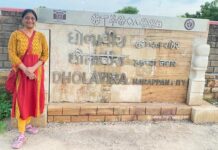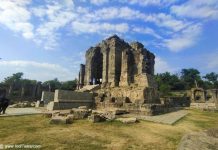We have heard of the Sanskrit poet Kalidasa. We have heard his stories, we know his literary works. But not many of us know of the physical spaces in India that are associated with him. A big rock standing on plains roughly in the shape of an elephant forms a hillock with several caves in it called Ramgarh. In the current day, the Sarguja district of Chhattisgarh is the place where Kalidasa is supposed to have lived after he left Ujjain.

Kalidasa Natyashala, Ramgarh
One of these caves in Ramgarh is supposed to be the ancient amphitheater or Natyashala where the plays of Kalidasa were performed. Going by similar modern structures it is difficult to imagine how plays were performed here. But I guess we have to go back in time and understand that the population was small. Communities were intimate and caves were homes. What is worth noting is the amazing acoustics this platform has. A small sound on the platform in the cave can be heard in quite a big area very clearly.
Now is this not the first and foremost requirement for an amphitheater? There are holes in the caves that may have been used to put some kind of curtains. The semi-circular formation can easily seat 50-60 people.

Kalidasa Poet
It is said that when Kalidasa left Ujjain after a fight with King Raja Bhoj he settled here. And composed his most well-known work Meghdootam here in the hills of Ramgarh. Even today on the first day of Hindi month Ashadh cultural programs are organized here. Below the hill is a modern stage with a painting depicting the times of Kalidasa and quoting his works in Devanagari.

Sita & Ramayana
Some of the adjoining caves have cave paintings. But I could not locate those caves. This cave with the amphitheater is supposed to have been used by Sita in Ramayan. During the Vanvaas or stay in the forest. It is locally known as Sita Bengra. Some people also believe that Sita was abducted from here by Ravan and taken to Lanka. And the place does fall on the way to Lanka on the ancient road connecting Prayag to Rameshwaram. Some inscriptions have also been found in this cave. Though I am not sure if they have been deciphered.

Stone hills here have natural caves and passages that are carved out to go to the other side of the hill. There are water sources that flow through these caves. Indicating that life could have been easily sustained here. Today, there are proper steps to go up the hill. But the last mile to the amphitheater is still a challenge. There are some carved stone images around the cave. Some images were laid on the red cloth with some rice in front of it. And some small change and coins on it. Indicating a place where you should donate when visiting Ramgarh.

At the time I visited this place in March-end, there was a Mela or a fair going on below the hill. And like a typical Indian fair, it has colors and faith supported by huge Mithai and Chaat shops.
Recommend you to read the following Tourist Places in Chhattisgarh.
Temple of Devrani Jethani, Tala, Bilaspur
Purkhauti Muktangan – An Ode To Ancestors














Wow ! I did not know about this place. Come to think of it, i never thjought about where Kalidas may have written his plays.
Thanks for sharing, Anuradha.
Ohh!! I like to see origin or Meghdootam 🙂
Amazing photos. I have heard of this place but not been there.
Thanks for sharing this. I had never heard of it or Kalidas.
very useful info thanks anuradha
Great work. Thanks for sharing.